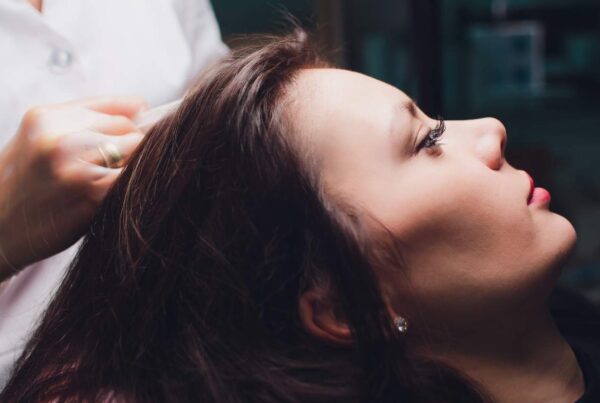If you’re losing your hair, it can be difficult to know whether it’s something temporary or if it’s an indicator of something more serious. If you live in Italy and you’re looking to restore your hair, this guide can help you understand what might be causing your hair loss and how you can correct the issue to grow back the hair you once had.
Hair loss can be caused by many things, including stress, aging, infections, certain medications, and even genetics. When hair loss becomes an issue, it can be both physically and emotionally distressing.
Many people turn to hair restoration treatments to fix the problem; however, if your hair loss is caused by an underlying medical condition, these treatments may not be appropriate.
Either way, our hair restoration center in Milan can help uncover the cause of your hair loss and then help to restore it.
Let’s take a look at some of the diseases that cause hair loss so you know whether or not you need to seek medical treatment first.
Alopecia Areata
This is an autoimmune disease that causes hair to fall out on different areas of your body. The disease affects men and women in Italy equally, usually striking people under thirty years old.
Treatment includes steroids, immunomodulators, or topical or intralesional corticosteroids.
This disease may also be mistaken for other illnesses like psoriasis.
People who suffer from alopecia areata can live normal lives without treatment, but you should consult a doctor if you experience thinning hair over a significant portion of your scalp.
Alopecia Areata typically will go away with time, especially if it’s caught early enough and treated properly. If you’re worried about losing more hair than usual, visit a dermatologist as soon as possible, or our expert team of specialists in Milan.
There are some cases where alopecia areata becomes permanent once it becomes chronic, however these cases are few and far between.
Androgenetic Alopecia
Male-pattern baldness is by far the most common form of hair loss, both in Italy and around the world.
As many as half of all men experience significant hair thinning at some point in their lives, and while women can have a version of male-pattern hair loss, they are more likely to experience diffuse hair thinning. It’s called female-pattern alopecia or FPHL for short.
Androgenetic alopecia is caused by an increase in testosterone (in both men and women), which leads to shorter (miniaturized) hairs and eventual balding. Diffuse hair loss occurs when your hair follicles slowly decrease in size until no hairs grow out of them anymore. The hairs that do remain grow thinner each day—they get smaller and thinner until there’s no bulb left. Some people refer to it as baby hair.
Women sometimes get what is known as postpartum alopecia—excessive shedding 6 months after delivery due to hormonal changes associated with pregnancy, breastfeeding, birth control pills, etc.
Androgenetic alopecia is genetic in nature and can’t be prevented. In short, if it’s going to happen then it’s going to happen.
Don’t worry! Our expert hair restoration specialists in our Milan center are fully capable of working with you to restore your hair if you experience male-pattern baldness.
Cicatricial Alopecia
As its name suggests, cicatricial alopecia involves tissue degeneration.
The most common form of cicatricial alopecia is known as scarring alopecia or trichotillomania. This condition is caused by chronic, repetitive inflammation in one area of hair follicles that causes scarring of hair shafts and damage to surrounding skin.
Over time, affected hair follicles are replaced with scar tissue that prevents new hair growth.
Scarring alopecia typically affects people between puberty and early adulthood. Common conditions that can cause scarring alopecia include lichen planopilaris (inflammation of hair roots), pseudopelade (scarring hair loss on top of scalp), discoid lupus erythematosus (damaged hair follicles with associated rashes) and certain types of anemia.
Certain medications, including chemotherapy drugs used for cancer treatment, can also lead to permanent hair loss.
Cicatricial alopecia is not curable but can be treated medically or surgically by our specialists at Starks.
Traction Alopecia
One of the most common causes of hair loss, traction alopecia occurs when your hair is subjected to excessive tension. This can be caused by tight braids, cornrows, weaves or any other style that pulls at your hair for an extended period of time.
Severe cases may need surgical treatment to repair damage caused by traction alopecia. Fortunately, you can treat less serious cases with low-level laser therapy and topical solutions designed to encourage regrowth and prevent further thinning and breakage.
While it’s not possible to completely cure traction alopecia, these treatments are still well worth exploring if your hair continues to fall out in clumps, and our specialists are fully capable of helping.
Starks Hair Restoration Center in Milan
For people in Italy who are suffering from hair loss, Starks can help.
Our team of medical experts and doctors who specialize in helping people just like you regain a full head of hair are perfectly equipped to help you with your problem.
Whether your hair loss is caused by disease, medication, stress, or anything else, we can help find the root of the problem and work with you to develop a plan to overcome it.
If you are a person in Italy who is experiencing hair loss, contact us today and schedule a free consultation. Our specialists and doctors will uncover the cause of your hair loss problem. Then we will work with you to develop a restoration plan that is tailored to your specific needs.
Please click below to find out more about the hair restoration services we offer to our global clientele:
France:
Greffe De Cheveux
Italy:
Trapianto Di Capelli
Greece:
Μεταμόσχευση μαλλιών




